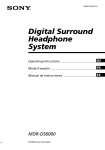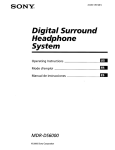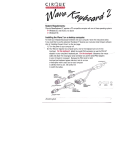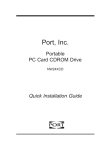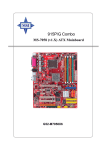Download Memorex RF6000 User`s guide
Transcript
USER’S GUIDE RF6000 Wireless Keyboard & Optical Mouse IMPORTANT NOTICE! The information in this document is subject to change without notice and does not represent a commitment on the part of the vendor. No warranty of representation, either expressed or implied, is made with respect to the quality, accuracy or fitness for any particular purpose of this document. The manufacturer reserves the right to make changes to the content of this document and/or the products associated with it at any time without obligation to notify any person or organization of such changes. In no event will the manufacturer be liable for direct, indirect, special, incidental or consequential damages arising out of the use or inability to use this product or documentation, even if advised of the possibility of such damages. Copyright © 2003. All rights reserved IBM, PC/AT and PS/2 are registered trademarks of International Business Machines Corporation. Microsoft, Windows, and Windows NT are registered trademarks of Microsoft Corporation in the United States of America and/or other countries. All other trademarks are trademarks of their respective holders. TABLE OF CONTENTS PAGE 1. Introduction 1 2. System Requirements 2 3. Installing the Keyboard and Mouse Set 3 3.1 Getting the Receiver Ready 3 3.2 Getting the Keyboard Ready 4 3.3 Getting the Mouse Ready 4 4. Wireless ID Setting 6 4.1 Synchronizing the IDs of your Receiver, Keyboard and Mouse 4.2 Replacing Batteries and Resetting ID Buttons 5. Software Installation 6 7 8 5.1 Keyboard Driver Installation 8 5.2 Mouse Driver Installation 9 6. Using the Keyboard and Mouse 10 6.1 Using the Keyboard 10 6.2 Using the Mouse Driver 11 7. Troubleshooting 11 1. Introduction Congratulations on your purchase of the Memorex® RF6000 Wireless Keyboard and Optical Mouse! This keyboard and mouse will finally free you from the constraints of your desktop by providing a wireless connection between your keyboard/mouse and your PC. Pass around the keyboard or mouse during meetings without worrying about a cable blocking your way, or write e-mails and surf the Internet from the comfort of your living room couch! The RF6000 Keyboard and Mouse combo consists of a keyboard, an optical mouse and a receiver. The receiver is connected to your PC through a cable, with a connector for both the keyboard and the mouse. Because the keyboard and mouse use radio frequencies to transmit wireless signals, interference from other wireless devices, like TV remote controls and cordless phones, is reduced. Besides providing unprecedented freedom of movement, this combo also offers extra functionality by introducing dedicated buttons for often used Internet Browser and Sleep functions. And since the mouse comes with rechargeable batteries and a Mouseport™ charging station, so you'll never have to worry about your mouse batteries running out of life again. In order to enjoy your keyboard and mouse to their full potential we recommended you read this manual carefully prior to use. What’s in this package • • • • • • • • • 1 Wireless Keyboard Wireless Optical Mouse RF Wireless Receiver Mouseport™ Charging station AC Power Supply Removable Wrist Rest Driver CD 2 Alkaline AA Batteries 2 AAA Rechargeable Batteries 2. System Requirements • IBM PC or Compatible • Available PS/2 Keyboard Port and Mouse Port • CD-ROM or DVD drive (for driver installation) • Microsoft Windows 98 SE, Windows Me, Windows NT 4.0 SP6, Windows 2000 or Windows XP operating systems • Microsoft Internet Explorer 5.0 or later version (for the Internet keys) Please refer to table below for the other system requirements for the features: Function Description Operating System Windows 98SE / Windows NT 4.0 SP6 Windows Me / Windows 2000 / Windows XP Wireless functionality Available immediately after hardware installation and synchronization Available immediately after hardware installation and synchronization Keyboard extra Multimedia buttons Requires keyboard driver software installation (see driver CD for details) Requires keyboard driver software installation (see driver CD for details) Keyboard extra ACPI buttons Requires enabling of system ACPI (Power Management) function Available immediately after hardware installation Mouse driver shortcut function Requires installation of mouse software driver (see driver CD for details) Requires installation of mouse software driver (see driver CD for details) Battery Low function Requires installation of keyboard driver (see driver CD for details) Requires installation of keyboard driver (see driver CD for details) LED Light function Requires installation of keyboard driver (see driver CD for details) Requires installation of keyboard drive (see driver CD for details) NOTE: Prior to the installation process, please be sure that you have fully charged your AAA rechargeable batteries in your Mouse with your Mouseport™ charger for more than 8 hours before you connect and synchronize your Mouse with your computer. Failure to do so could result in batteries that drain rapidly and or do not work at all. 2 3. Installing the Keyboard and Mouse Set This wireless keyboard and mouse combo consists of a receiver that plugs into the computer, a wireless keyboard, a wireless mouse, and a Mouseport™ charging station. 3.1 Getting the Receiver Ready Connect the receiver and select a wireless channel: 1. Make sure your PC is switched off. 2. Turn the receiver over and find the channel slide switch. Select either channel CH1 or CH2. Remember which channel you selected. Bottom View of Receiver Slide Switch Setting of Receiver 3. Connect the receiver to your PC: Plug the receiver's green PS/2 connector into the mouse port of your computer. Plug the receiver's purple PS/2 connector into the keyboard port of your computer. 4. Set the receiver flat on a surface and follow these guidelines: a. There should be a minimum of 8 inches clearance between the receiver and other electronic devices. b. There should be a minimum of 8 inches clearance between the receiver and the monitor. c. The mouse and keyboard can operate at a range of up to 6 feet. d. For better reception, the receiver works best on a nonmetallic surface. 3 3.2 Getting the Keyboard Ready Install the two AA alkaline batteries (provided) into the keyboard and select a wireless channel: 1. Turn the keyboard over and find the battery compartment. Lift the cover. 2. Insert the include AA alkaline batteries into the compartment. Make sure the batteries are placed in the correct direction by following the polarity signs in the battery compartment. Battery AA 1.5V 2pcs (-) (+) ID Button Slide Switch Bottom View of Keyboard 3. Use the slide switch on the back of the keyboard to select the same channel as the one you selected for the receiver. Slide Switch Setting of keyboard 3.3 Getting the Mouse Ready Install the two AAA rechargeable batteries (provided) into the mouse, select the same wireless channel as the receiver, and charge the batteries for a minimum of 8 hours prior to using the mouse with your computer. Important: Use only rechargeable batteries in this mouse when it is being used with the Mouseport™ charger. Use of Alkaline batteries while using the Mouseport™ charger may cause the batteries to overheat and burst! The provided rechargeable batteries need to be charged for 8 hours before first use. 1. Turn the mouse over and find the battery compartment. Lift the cover. Bottom View of Mouse Battery Compartment Channel Slide Switch 4 2. Use the slide switch, located inside the battery compartment of the mouse, to select the same channel as the one selected on the receiver and on the keyboard. Channel Slide Switch 3. Insert the included AAA rechargeable batteries into the compartment. Follow the polarity signs in the battery compartment and make sure the batteries are placed in the correct direction 4. Replace the battery compartment lid and place the mouse in the Mouseport™ charging station. 5. Connect the included AC adapter to the Mouseport™ and plug the power supply into an electrical outlet. 6. Make sure the green light on the Mouseport™ is on to confirm that power is being supplied. 7. Let the mouse charge for 8 hours before first use with your computer. Notes: 1. The keyboard uses two pieces of standard UM-3 (AA) 1.5V batteries, and the mouse uses two pieces of rechargeable (AAA) batteries. 2. Battery life for the keyboard is approximately 3-4 months, depending on the intensity of usage. Battery life for the mouse is approximately 8 hours between charges. 3. Make sure the receiver is at least 8 inches away from the monitor and is placed in a location relatively free of strong electromagnetic or transmission sources. This helps to ensure optimal reception of the keyboard and mouse signal. 4. Your computer should be off during the entire hardware installation and channel selection process. 5. The rechargeable batteries for the mouse must be charged for 8 hours before first use. 5 4. Wireless ID Setting The mouse, keyboard and receiver each contain two channels, and each channel contains 256 IDs that are randomly selected when you press the ID button. This ID-recognition function helps protect against interference from other wireless devices in the same environment. After installing the hardware, inserting the batteries and charging the mouse batteries, you must set the IDs of the receiver, mouse and keyboard. This process should happen while your system is booting-up, but before logging in to Windows. Important: Whenever you want to set the IDs of both the keyboard and mouse, you must first set the receiver ID and keyboard ID, and then set the receiver ID and mouse ID, as described in this procedure. 4.1 Synchronizing your Receiver, Keyboard and Mouse 1. Turn the computer on. 2. Press the ID button on the top of the receiver once. The LED light will start to blink. ID Button ID Button of Receiver 3. Turn the keyboard over and locate the ID button near the left footpad. Press the ID button with a blunt pointed object (like the tip of a ballpoint pen), and hold until the receiver light is solid. This may take up to 20 seconds. Battery AA 1.5V 2pcs (-) ID button of Keyboard (+) ID Button Slide Switch 1 2 Important: If 30 seconds pass before you complete step 3, you must repeat steps 2 and 3 to set the keyboard ID. If the ID button is pressed more than one time during the keyboard setup (step 3), you must start over with step 2 and set the receiver ID. 4. Press the ID button on the top of the receiver once. The LED light will start to blink. ID Button ID Button of Receiver 6 5. Turn the mouse over and locate the ID button near the top. Press the ID button with a blunt pointed object, like the tip of a ballpoint pen, and hold until the receiver light is solid. This may take up to 20 seconds. ID button of Mouse Important: If 30 seconds pass before you complete step 5, you must repeat steps 4 and 5 to set the mouse ID. If the ID button is pressed more than one time during the mouse setup (step 5), you must start over with step 4 and set the receiver ID. You do not need to reset the keyboard ID. 6. To quickly verify that your new keyboard and mouse are properly synchronized, depress a key or two on your keyboard. If the LED on the Receiver blinks steadily, then it has made the connection. For the mouse, simply move it around on a flat surface and click a button or two. If the LED on the receiver blinks fast and steady, then the mouse has made the connection as well. 7. Now both the keyboard and mouse should be communicating properly. If they do not seem to work please check for proper installation of the batteries and repeat the steps again. Notes: 1. You must follow the procedure above to set the ID of the receiver, keyboard and mouse. 2. Once the receiver ID button is pressed you have 30 seconds to complete the entire process, or you will need to begin again. 4.2 Replacing Batteries and Resetting ID Buttons When the batteries are low, a battery low icon will show on the rightbottom corner of the taskbar instead of the keyboard driver software icon . . At that time you must either charge the mouse batteries or replace the keyboard batteries with new batteries. IDs need to be reset when batteries are changed. If you use rechargeable mouse batteries with the Mouseport™, then this only applies to the keyboard. When changing the batteries of the keyboard, you do not need to reset all the IDs. Simply reset the ID for the receiver and keyboard. You must press the receiver ID button first and then press the keyboard ID button. Refer to steps 2 and 3 above. 7 5. Software Installation After finishing the hardware installation as described in this manual and starting up your PC, you should be able to immediately take advantage of the wireless benefits of the RF6000 keyboard and mouse. If the keyboard and mouse are not working properly, see section 7 "Troubleshooting" for tips on how to solve your problem. 5.1 Keyboard Driver Installation If your operating system is Windows Me, Windows 2000 or Windows XP, you can immediately take advantage of the extra function buttons on the keyboard (except "Battery Low" and "LED Light" functions) without installing the keyboard driver software. However, it is recommended that you do install the included Keyboard software drivers so that we can ensure full functionality and support for your new Keyboard. If your operating system is Windows 98 SE or Windows NT 4.0 SP6, you will need to install the keyboard driver software to take advantage of these functions. The keyboard software driver program is located on the driver CD included in the box. Important: If you are using a version of Windows not listed above, there is no need to install the software. The software does not support this programmability feature for older versions of Windows. 1. Insert the driver CD into your computer’s CD-ROM drive. 2. Select "Installation Memorex RF6000 (for keyboard driver)." 3. Follow the on-screen instructions to finish the installation procedure. 4. For detailed information on how to install the driver, please refer to the readme.htm file located in the RF6000 folder within the keyboard-driver subfolder of your driver CD. Note: Once you insert the installation CD in step 1, the installation should begin automatically. However, if the installation does not begin automatically, you may need to do the following: 1. Click on the Start menu, then Click on the Run button. 2. Browse to the drive where the Installation CD is located. 3. Select the Autorun.exe file, then click on the Open button. 4. Click on OK to start the installation manually. 5. Select installation options for the RF6000 devices and follow the onscreen instructions. 8 5.2 Mouse Driver Installation In order to take advantage of the special shortcut button functionality of the mouse you will need to install the mouse driver which is located on the driver CD included in the box. 1. Make sure the driver CD is in your computers CD-ROM drive. 2. Select "Installation Memorex RF6000 (for mouse driver)." 3. Follow the on-screen instructions to finish the installation procedure. Note: If you restarted your computer after the keyboard driver installation as prompted, the installation CD process may not automatically launch and you will need to do the following: 1. Click on the Start menu, then Click on the Run button. 2. Browse to the drive where the Installation CD is located. 3. Select the Autorun.exe file, then click on the Open button. 4. Click on OK to start the installation manually. 5. Select installation options for the RF6000 devices and follow the onscreen instructions. 9 6. Using the Keyboard and Mouse 6.1 Using the Keyboard Besides the usual keyboard keys, the RF6000 keyboard also has extra dedicated keys which provide the following multimedia functionality: Important: In order to use these keys under Windows 98 SE or Windows NT 4.0 SP6, it is necessary to have the keyboard driver installed and is recommended for Windows Me, 2000 and XP as well. Please refer to section 5 for more information. Function Buttons . Power Off Turns the computer off Sleep Places the computer in sleep mode Wake Up Wakes the computer from sleep mode WWW Opens the default internet browser on the machine Search WWW Opens the internet search menu Favorites Folder Opens the internet favorites folder Back Displays the previously viewed page Forward To view the page displayed before clicking the Back button Email Opens the default email program Volume Control Adjusts the volume up and down Stop Stops the audio and resets the tracks to the first track in the sequence Mute Mutes the sound Next/Fast Forward Advances to the next audio track .. Play/Pause Begins audio tracks, pause will temporarily stop the track from playing Previous/Fast Backward Advances to the previous audio track 10 Attaching the Wrist Rest At your discretion, you may choose to connect the wrist rest with the keyboard. To connect the wrist rest to the keyboard, follow the images below: 6.2 Using the Mouse After installing the mouse driver as described in section 5, you will be able to start using the Mouse Control Panel by right clicking on the Mouse icon in the Windows task bar. This icon should appear after restarting your computer. The optical mouse uses a light to sense movement. Use the optical mouse on an opaque surface; the optical mouse cannot work on a glass, translucent, or reflective surface. The mouse goes into a sleep or suspend mode after 10 minutes of inactivity. Move the mouse or click a button to wake it. You may notice that the mouse moves the cursor on the screen twice as fast as a standard mouse does. The mouse moves the cursor at 800 dots per inch (dpi) while a standard mouse moves the cursor at 400 dpi. Change the cursor movement speed by using the mouse properties in the Control Panel. 7. Troubleshooting If you are experiencing problems with your keyboard or mouse please check the following: 1. Take out the receiver's connectors and check both of the receiver's mouse and keyboard plugs for possible broken pins. If the plugs appear normal then reinsert the plugs into their respective connectors on your PC. 11 2. Make sure the mouse plug is inserted in the mouse connector on your PC and the keyboard plug is inserted into the keyboard connector on your PC. Compare the icons on both the cable and backside of your PC if necessary. 3. Check to see if the batteries in the keyboard and mouse are installed correctly. Make sure the polarity of the batteries corresponds with the polarity signs in the battery compartment. 4. Replace the keyboard batteries and/or charge the mouse batteries to make sure the batteries are not low in power. If you are replacing the keyboard batteries, you will need to reset the ID (see section 4.2). The mouse batteries must be charged for 8 hours before initial use. 5. Check to see if the channel switch for the receiver, keyboard and mouse are set to the same channel. Try the alternate channel for the receiver, keyboard and mouse in case the initially selected channel appears to work improperly. 6. Other devices in the vicinity of the receiver may cause interference. It is strongly recommended to place the receiver at least 8 inches away from the monitor and other electronic devices in order to prevent signal disturbance. For better reception, use the receiver on nonmetallic surfaces. 7. If your PC system's BIOS setup has options for the keyboard or mouse, make sure they are set to default settings. If you are not familiar with the BIOS, refer to your PC's manual for more information. 8. If you have problems using the sleep button, make sure that the power management in your PC has been enabled both in the BIOS and in Windows. For more information on your PC's BIOS settings refer to your PC's manual. For more information on how to enable the power management features in Windows refer to your Windows manual. 9. If you have problems using the extra browser buttons and/or the special mouse functions, make sure you have installed the keyboard and mouse driver correctly as described in section 5 "Software Installation." Also check that your hardware requirements meet those listed in this manual. 10. Use the mouse only on a clean, flat surface in order to ensure smooth and accurate cursor action. Do not use the mouse on glass, translucent, or reflective surface. 11. Keep all items away from direct sunlight, moisture, dirt, extreme heat and abrasive chemical (cleaning) solutions. 12. Should the receiver, the keyboard or mouse become accidentally immersed or splashed by liquids, switch off your PC immediately, unplug all items and refer to your dealer for further assistance. 12 Technical Support For more information on how to use the RF6000 Keyboard and Mouse, please visit the Memorex website at www.memorex.com/products and follow the links to the Keyboard product listings for additional product information and guides. If you need any additional help in connecting, synchronizing or installing the RF6000, please feel free to contact Memorex's technical support. Email [email protected] with your questions, or visit us online at www.memorex.com for our Frequently Asked Questions. Phone support is available at (310) 891-1680 from the hours of 9:00am to 6:00pm, PST. M-F. Product Registration To register your product please visit us online at www.memorex.com or write to us with your name, address, phone number, model name, model number, date of purchase and please of purchase at: Memorex Products, Inc. 10100 Pioneer Blvd, Suite 110, Santa Fe Springs, CA 90670. Warranty Information Memorex Products, Inc. ("Memorex") warrants this product, excluding connected equipment, against defects in materials and workmanship for one year from the date of original purchase. PURCHASER'S REMEDY IS LIMITED TO REPAIR OR REPLACEMENT OF ANY DEFECTIVE PRODUCT. THIS WARRANTY AND REMEDY IS EXCLUSIVE AND WE SPECIFICALLY DISCLAIM ANY AND ALL OTHER EXPRESS OR IMPLIED WARRANTIES. IN NO EVENT SHALL MEMOREX OR ANY SUPPLIER OR SELLER BE RESPONSIBLE FOR ANY DIRECT, SPECIAL, INCIDENTAL, CONSEQUENTIAL OR ANY OTHER DAMAGES OF ANY KIND. For further information regarding warranty service, please go to www.memorex.com 13 FCC Guidelines: This equipment has been tested and found to comply with the limits for a Class B digital device, pursuant to Part 15 of the FCC Rules. These limits are designed to provide reasonable protection against harmful interference in a residential installation. This equipment generates, uses and can radiate radio frequency energy and, if not installed and used in accordance with the instructions may cause harmful interference to radio communications. However, there is no guarantee that interference will not occur in a particular installation. If this equipment does cause harmful interference to radio or television reception, which can be determined by turning the equipment off and on, the user is encouraged to try to correct the interference by one or more of the following measures: • Reorient or relocate the receiving antenna • Increase the separation between the equipment and receiver • Connect the equipment into an outlet on a circuit different from that to which the receiver is connected. • Consult the dealer or an experienced radio/TV technician for help. The Class B digital apparatus meets all requirements of the Canadian Interference-Causing Equipment Regulation. Cet appareil numerique de la class B respecte toutes les exigences du Reglement sur le materiel brouilleur du Canada. Caution: Any changes or modifications not expressly approved by the party responsible for compliance could void the user's authority to operate this equipment. Shielded interface cable, if any, must be used in order to comply with emission limits. 14 ©2003 Memorex Products, Inc. • Santa Fe Springs, CA 90670 • www.memorex.com All other brand or product names are trademarks or registered trademarks of their respective owners. 5395 6170



















